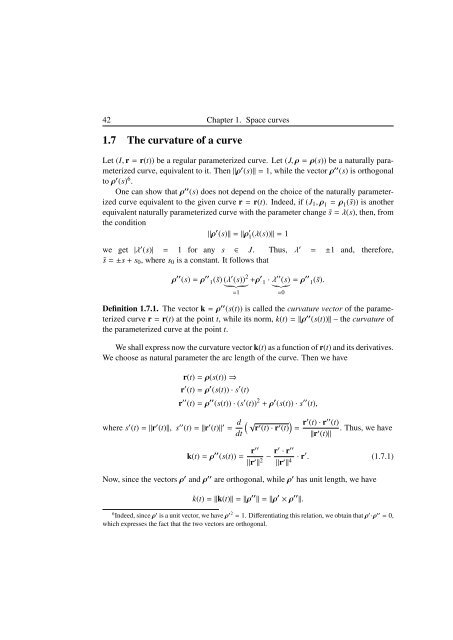Blaga P. Lectures on the differential geometry of - tiera.ru
Blaga P. Lectures on the differential geometry of - tiera.ru
Blaga P. Lectures on the differential geometry of - tiera.ru
You also want an ePaper? Increase the reach of your titles
YUMPU automatically turns print PDFs into web optimized ePapers that Google loves.
42 Chapter 1. Space curves<br />
1.7 The curvature <strong>of</strong> a curve<br />
Let (I, r = r(t)) be a regular parameterized curve. Let (J, ρ = ρ(s)) be a naturally parameterized<br />
curve, equivalent to it. Then �ρ ′ (s)� = 1, while <strong>the</strong> vector ρ ′′ (s) is orthog<strong>on</strong>al<br />
to ρ ′ (s) 6 .<br />
One can show that ρ ′′ (s) does not depend <strong>on</strong> <strong>the</strong> choice <strong>of</strong> <strong>the</strong> naturally parameterized<br />
curve equivalent to <strong>the</strong> given curve r = r(t). Indeed, if (J1, ρ 1 = ρ 1(˜s)) is ano<strong>the</strong>r<br />
equivalent naturally parameterized curve with <strong>the</strong> parameter change ˜s = λ(s), <strong>the</strong>n, from<br />
<strong>the</strong> c<strong>on</strong>diti<strong>on</strong><br />
�ρ ′ (s)� = �ρ ′ 1 (λ(s))� = 1<br />
we get |λ ′ (s)| = 1 for any s ∈ J. Thus, λ ′ = ±1 and, <strong>the</strong>refore,<br />
˜s = ±s + s0, where s0 is a c<strong>on</strong>stant. It follows that<br />
ρ ′′ (s) = ρ ′′ 1(˜s) (λ ′ (s)) 2<br />
��������<br />
=1<br />
+ρ ′ 1 · λ ′′ (s) = ρ<br />
����<br />
=0<br />
′′ 1(˜s).<br />
Definiti<strong>on</strong> 1.7.1. The vector k = ρ ′′ (s(t)) is called <strong>the</strong> curvature vector <strong>of</strong> <strong>the</strong> parameterized<br />
curve r = r(t) at <strong>the</strong> point t, while its norm, k(t) = �ρ ′′ (s(t))� – <strong>the</strong> curvature <strong>of</strong><br />
<strong>the</strong> parameterized curve at <strong>the</strong> point t.<br />
We shall express now <strong>the</strong> curvature vector k(t) as a functi<strong>on</strong> <strong>of</strong> r(t) and its derivatives.<br />
We choose as natural parameter <strong>the</strong> arc length <strong>of</strong> <strong>the</strong> curve. Then we have<br />
r(t) = ρ(s(t)) ⇒<br />
r ′ (t) = ρ ′ (s(t)) · s ′ (t)<br />
where s ′ (t) = �r ′ (t)�, s ′′ (t) = �r ′ (t)� ′ = d<br />
dt<br />
r ′′ (t) = ρ ′′ (s(t)) · (s ′ (t)) 2 + ρ ′ (s(t)) · s ′′ (t),<br />
� √ � r<br />
r ′ (t) · r ′ (t) = ′ (t) · r ′′ (t)<br />
�r ′ . Thus, we have<br />
(t)�<br />
k(t) = ρ ′′ (s(t)) = r′′<br />
�r ′ � 2 − r′ · r ′′<br />
�r ′ � 4 · r′ . (1.7.1)<br />
Now, since <strong>the</strong> vectors ρ ′ and ρ ′′ are orthog<strong>on</strong>al, while ρ ′ has unit length, we have<br />
k(t) = �k(t)� = �ρ ′′ � = �ρ ′ × ρ ′′ �.<br />
6 Indeed, since ρ ′ is a unit vector, we have ρ ′2 = 1. Differentiating this relati<strong>on</strong>, we obtain that ρ ′ ·ρ ′′ = 0,<br />
which expresses <strong>the</strong> fact that <strong>the</strong> two vectors are orthog<strong>on</strong>al.












